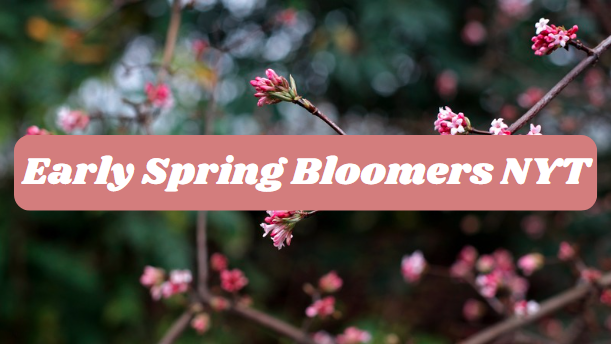Introduction
Spring is a time of renewal, with the earth awakening from its winter slumber. One of the most delightful aspects of this season is the emergence of early spring bloomers. These resilient flowers break through the cold, often bringing the first hints of color to gardens and landscapes.
For those who enjoy solving crosswords, particularly the New York Times (NYT) crosswords, the term “early spring bloomers” is often a recurring theme. This article delves deep into the world of early spring bloomers, exploring their significance, how to identify them, and their connection to NYT crosswords.
Understanding Early Spring Bloomers
Early spring bloomers are plants that flower early in the spring season, sometimes even before the last frost has disappeared. These plants have adapted to cold conditions, allowing them to blossom when most other plants are still dormant.
Common examples include crocuses, snowdrops, and daffodils. Their vibrant colors and delicate petals are often the first signs of spring, symbolizing hope and new beginnings.
NYT Crosswords: A Unique Connection
The New York Times crossword puzzles are renowned for their challenging and clever clues. Among the various themes and topics, “early spring bloomers” frequently appear as clues, requiring solvers to identify specific flowers that bloom in early spring.
This connection adds an element of botanical knowledge to the art of crossword solving, blending horticulture with mental exercise.
Identifying Popular Early Spring Bloomers
Crocus
Description: Crocuses are among the first flowers to bloom in the spring. They come in various colors, including purple, yellow, and white.
Characteristics:
- Small, cup-shaped flowers
- Bloom in clusters
- Often found in meadows, woodlands, and gardens
Growing Tips: Plant crocus bulbs in well-drained soil during the fall. They prefer sunny or partially shaded areas.
Snowdrop
Description: Snowdrops are delicate white flowers that bloom in late winter to early spring. They are often seen pushing through the snow.
Characteristics:
- Small, bell-shaped flowers
- White petals with a green mark
- Typically bloom in clusters
Growing Tips: Plant snowdrop bulbs in moist, well-drained soil. They thrive in shaded or partially shaded areas.
Daffodil
Description: Daffodils, also known as narcissus, are vibrant yellow flowers that are synonymous with spring.
Characteristics:
- Trumpet-shaped flowers
- Long stems
- Varieties in white and orange
Growing Tips: Plant daffodil bulbs in the fall. They prefer sunny locations and well-drained soil.
Hyacinth
Description: Hyacinths are known for their fragrant, colorful spikes of flowers that bloom in early spring.
Characteristics:
- Dense clusters of star-shaped flowers
- Colors include blue, pink, white, and purple
- Strong, sweet fragrance
Growing Tips: Plant hyacinth bulbs in well-drained soil during the fall. They require full sun to partial shade.
Expert Tips for Solving Early Spring Bloomers NYT Crossword Clues
- Familiarize with Common Bloomers: Knowing common early spring bloomers like crocus, snowdrop, and daffodil can make solving clues easier.
- Context Clues: Use other words in the crossword puzzle to help narrow down the options.
- Synonyms and Variants: Be aware of synonyms and different names for flowers. For example, “narcissus” can also refer to daffodils.
- Cross-referencing: Use letters from intersecting words to help identify the correct flower name.
- Practice: Regularly solving crosswords will improve your ability to recognize and solve botanical clues.
The Significance of Early Spring Bloomers in Gardens
Early spring bloomers play a crucial role in gardens. They provide the first burst of color after winter, creating a visually appealing landscape. These flowers also support early pollinators, such as bees and butterflies, which are vital for the ecosystem. Additionally, early spring bloomers often require less maintenance and can thrive in various soil conditions.
Cultivating Early Spring Bloomers in Your Garden
Choosing the Right Location
- Sunlight: Most early spring bloomers prefer full sun or partial shade.
- Soil: Well-drained soil is essential to prevent bulb rot.
Planting Tips
- Timing: Plant bulbs in the fall, several weeks before the first expected frost.
- Depth: Plant bulbs at a depth of 2-3 times their height.
- Spacing: Space bulbs according to the variety, usually a few inches apart.
Maintenance
- Watering: Water bulbs after planting and during dry periods.
- Fertilizing: Use a balanced fertilizer in the fall and early spring.
- Mulching: Apply mulch to retain moisture and regulate soil temperature.
Ecological Impact of Early Spring Bloomers
Early spring bloomers contribute significantly to the environment. They provide nectar and pollen for early pollinators, helping to sustain bee populations. These flowers also prevent soil erosion with their root systems and enhance soil fertility as they decompose. Incorporating early spring bloomers into your garden supports biodiversity and promotes a healthy ecosystem.
Frequently Asked Questions (FAQs)
Q: What are some other examples of early spring bloomers? A: Other examples include tulips, hellebores, and primroses.
Q: Can early spring bloomers grow in containers? A: Yes, many early spring bloomers can thrive in containers with proper care and suitable soil.
Q: How can I extend the blooming season of my early spring flowers? A: Plant a variety of species with different blooming times and ensure they receive adequate care.
Q: Are early spring bloomers deer-resistant? A: Some early spring bloomers, like daffodils and hyacinths, are deer-resistant. However, crocuses are more susceptible to being eaten by deer.
Q: How do I protect my early spring bloomers from late frost? A: Cover the plants with frost cloths or bring container plants indoors during cold snaps.
Conclusion
Early spring bloomers are a delightful and essential part of the gardening season. Their ability to thrive in cold conditions and bring early color to gardens makes them invaluable.
Additionally, their presence in NYT crosswords adds an intellectual challenge for enthusiasts. By understanding, identifying, and cultivating these flowers, you can enjoy the beauty and benefits they bring to your garden and environment.
Embrace the charm of early spring bloomers and let them inspire both your gardening and crossword-solving endeavors.





















+ There are no comments
Add yours